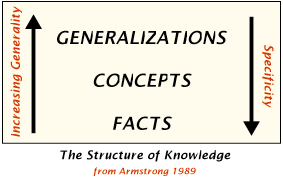Instruction
in the Social Studies Classroom:
Some Ideas and Strategies
“A
pupil from whom nothing is ever demanded which he cannot do, never does all he
can.”
John
Stuart Mill
Success
in education hinges on what happens at the classroom level!
Have
you ever reflected on how you learn?
Ask
your students—do you think they know how they learn?
Students
today seem relatively poor at explaining how they learn.
Teachers
have to teach students how to learn.
Task
Analysis
?
Key to unlocking the content
?
Determining prior knowledge
?
“Putting your finger” on what students need to learn
?
Bringing “exactness” to the Unpacked SOL
The
SOL are HUGE! The KEY—vocabulary!
Definition
of Task Analysis
Breaking
apart a learning goal or objective into sub-components and identifying essential
vocabulary.
When
to complete a task analysis?
Three
Times:
•
Vague, unclear SOL
•
Students are NOT Successful
•
New Material for You
What
are the advantages and uses?
•
For Teacher: Deepen Content Knowledge
•
For Students: Often points out the “Missing” Links
Use
it to determine prior student learning
The
process can be used to fit your needs. A
true task analysis is by definition complex and often time consuming.
Task Analysis requires looking for the details of an SOL to assure that
all the facts of the objective are on the table and known to the instructor.
Task analysis again should only be done if the instructor is unsure of
the content, feels the objective is vague, or has had students experience no
success with the standard.
Other
considerations include:
§
Key vocabulary
§
Verbs
§
Pre-requisites
§
Sequence
Most
important element: Vocabulary
Must be taught in context
Must be taught for classroom use
Bottom
line—What will the student have to learn to demonstrate mastery?
Plan
Backward
-
Teach
what you test
-
Test
what you teach
What
can teachers do to help students learn to learn?
?
Share and model self-monitoring
processes
–
Show students how you proofread and evaluate work
–
Show students how to analyze a piece of writing and make it better
–
Track your thinking processes for them
?
Explain strategies
–
Think out loud
–
Verbalize the steps you take to solve a problem, make a decision,
understand a challenging passage
?
Clarify why particular strategies are helpful
–
Three
kinds of knowledge
?
Declarative (knowing what)
?
Procedural (knowing how)
?
Conditional (knowing when)
–
Help
students know what works, when and how
?
Clarify and model appropriate strategies
–
Describe
visual images
–
Share
analogies to prior learning
–
Make
predictions
–
Develop
hypotheses
Top
Instructional Practices
?
Graphic organizers
?
Cooperative learning
?
Problem-based learning
?
Thematic instruction
?
Technology
?
Think aloud
?
Flex grouping
?
Focusing on the objective
?
Group projects
?
Directed instruction
?
Lecture
?
Wait time
?
Whole-class activities
Activate
Prior Knowledge
?
Brainstorming
–
Provide needed time to think, process, recall
–
Invite participation
?
Cognitive mapping
–
Mind maps help visualization
–
Graphic organizers
?
KWL
–
Know (write at beginning of session)
–
Want to learn (beginning)
–
Learn (ending summary)
Direct
Instruction
Hunter
model
?
Daily review
?
Presentation of new material
?
Guided practice
?
Provision for feedback
?
Independent practice
?
Periodic review
Collaborative
Processes
?
Working together
?
Keys to successful adult employment (Dept. of Labor)
?
Research shows collaborative work supports greater retention of subject
matter
?
Many different techniques
Collaborative
Learning Techniques
?
Round robin
–
Share in turn in a group
–
Brainstorm but in different format
?
Corners
–
Move to corners representing a teacher-determined alternative
–
Discuss then listen to and paraphrase ideas from other corners
?
Numbered Heads
–
Teacher asks question, group confers
–
Once student answers based on number called by teacher
?
Pairs Check
–
Work
in pairs in group of four
–
Students
alternate answering question
–
Check
with other pair
–
Coaching
each other
?
Think Pair Share
–
Think
to themselves
–
Pair
with another to discuss and share thoughts
–
Share
with class
?
Team Word Webbing
–
Students write simultaneously on a piece of paper drawing main
concepts, supporting elements, and bridges representing relationships of
concepts and generalizations
–
Compare maps when concluded
?
Inside Outside Circle
–
Stand in two concentric circles
–
Inside faces out, outside in
–
Flashcards to respond to teacher questions as they rotate to each new
partner
?
Peer or Cross Age Tutoring
–
Tutor a peer or younger students.
–
Best way to learn is to teach
–
Become experts
?
Jigsaw
–
Each group member is assigned a specific person to research (ex.
Framer of the Constitution)
–
Join expert groups (all individuals researching T. Jefferson) Learn
in this group of experts then return and share with home group.
?
Reciprocal Teaching
–
Used in discussing and verifying reading assignments
–
Four steps
?
Summarizing—students restate what they have read in their own
words
?
Generalizing questions—students ask questions about the material
?
Clarifying—students focus on reasons why the text is difficult to
understand and answer questions for each other
?
Predicting—students speculate on what will be next
Visual
Strategies
?
Images can make a lasting impression
?
Key to using film, video, slides is to build student involvement
?
Image analysis is a learned skill (check national archives and records
site for how to lesson/worksheet)
?
Modeling the skill and giving students opportunities to create their own
visual imaging (PowerPoint, Hyperstudio)

Teaching
Facts, Concepts, Generalizations
?
Facts are not relevant unless given meaningful context
?
All three ideas are interconnected and none can stand alone
Students
must be given lots of opportunities to move through the structure of
knowledge—to move from facts to concepts to generalizations.
Generalizations
?
Statements about relationships between and among concepts
?
True and verifiable
?
Organize and summarize information obtained from analysis of facts
?
Usually a broad assertion
Teaching
Generalizations
?
Two approaches
–
Inductive
(discovery method)
?
Students examine sets of data
and materials
?
Identify and explain key
points
?
Draw conclusions from the
data, summarize their findings, discover or infer the generalizations
–
Deductive
(expository method)
?
Students presented with a
potential generalization
?
They clarify key concepts
?
They verify the generalization
?
They identify or find new
cases of the generalization
How
to Help Students Generalize
?
Organize your teaching and lesson planning around generalizations
?
Always make students draw conclusions and make generalizations
?
Design assessments to reflect the learning activity
Teaching
Concepts
?
Concepts are the categories we use to cluster information
?
Concepts organize specific information under one label
?
Building blocks which help to link facts to generalizations
Facts
?
Fact is a truth only about a particular incident or case
?
Specific
?
Knowledge section of the Resource Guide
?
This is the specific details of social science
Examples
of Generalizations, Concepts, and Facts
?
Generalization
–
In the United States, Brown vs. Board of Education of Topeka was
a landmark Supreme Court case.
?
Concept
–
Many Virginians had their education disturbed in the 1950s due to
Massive Resistance.
?
Fact
–
In 1958, Governor J. Lindsey Almond closed six Norfolk schools to stop
their integration, putting 9,950 white children out of school.
Problem
Solving
?
Students use facts, concepts, and generalizations in the process of
finding solutions
?
Process skills
?
Step by step process
–
Stating the problem
–
Suggesting alternatives
–
Tracing consequences
–
Recognizing what is required to decide
–
Reaching a decision
IDEAL—Problem
Solving Model
?
I = identify the problem
?
D = define and represent the problem
?
E = explore possibilities (strategies)
?
A = act on the strategies
?
L = look back and evaluate the effects of your activities
Role
Play and Simulation
?
Effective means of helping students to engage in problem solving in real
world context
?
Can be difficult to do well
?
Five stages
–
Initiation and direction
–
Describing the context
–
Roles—define
–
Enactment
–
Debriefing
?
Students tend to focus on the “who won?” And not the process or
procedure
Discussion
?
Part of every social studies class
?
Sometimes degenerates into unreasoned debate
?
Must be managed
?
Must be pre-planned
?
Models exist such as
–
Padea
(Socratic Discussion)
–
Harvard
Social Studies Project Model (like formal debate format)
Inquiry
Teaching
?
Asking question
?
Students develop questions, collect and organize data
?
Analyze data
?
Draw inferences or conclusions
?
Scientific Method applied to social studies
?
Hallmark of the method is student activity
Graphic
Organizers
?
Concept maps, webs, mind maps, thinking maps (many names)
?
Tools to help students organize their thinking
?
Venn diagram
?
Cause/effect map
?
Story board
?
Decision Tree
?
Many, many more (see web address)
A
Traditional Curriculum
?
Class
routine is:
–
Written
–
Passive
–
Individual
–
Abstract
–
Rote-regurgitation
?
Student
dialog is:
–
What’s
the rule?
–
What’s
the date?
–
How
do you do it?
–
Tell
me what to do
–
So
WHAT?
–
It’s
done
–
Is
it right?
–
I’m
finished.
The
Virginia Standards of Learning promote a vision of a classroom that…
?
Ensures active involvement in learning;
?
Recognizes teachers and students as thinkers, doers, investigators, and
problem solvers;
?
Believes that all students can learn;
?
Encourages teachers to reflect on their teaching;
?
Uses real-life situations to make connections;
?
Calls on parents, educators, business, and government to be partners in
change.
Sources
|
 Fly
Fly